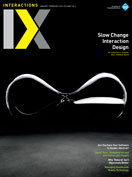Authors:
MARSUI (Malleable Audio-Reactive Shape-retaining User Interface) is a deformable hardware prototype exhibiting shape-retaining behavior. It can track the shape the user creates when deforming it. We envision that a set of predefined shapes could be mapped onto particular applications or functions. In its current implementation, we present three shapes that MARSUI can be formed into: a twist, a fold, and a bend. Since the malleable interface can also take other forms, feedback plays an important role in guiding the user toward the predefined shapes. In this project, we focus on investigating the possibilities that auditory feedback could offer in guiding the user toward reaching the intended shapes.
http://sopi.media.taik.fi/research/flint/
http://vimeo.com/74310106
Wikström, V., Overstall S., Tahiroğlu, K., Kildal, J., and Ahmaniemi, T. MARSUI: Malleable Audio-Reactive Shape-retaining User Interface. Proc. CHI '13 Extended Abstracts on Human Factors in Computing Systems. ACM, New York, 2013.
Koray Tahiroğlu, Finland Nokia Research Center
[email protected]
Valtteri Wikström, Finland Nokia Research Center
[email protected]
Simon Overstall, Finland Nokia Research Center
[email protected]
Thomas Svedström, Finland Nokia Research Center
[email protected]
Johan Kildal, Finland Nokia Research Center
[email protected]
Teemu Ahmaniemi, Finland Nokia Research Center
[email protected]
Mind Pool is a brain-computer interface designed to provoke self-reflection experiences based upon real-time representations of a participant's brain activity. Brain activity is sonically and physically represented via a magnetically reactive liquid sitting in a pool built into a tabletop. Feedback may be intentionally altered by those sitting at the Mind Pool by entering into differing mental, sensory, and bodily states or passively through observation of inherent brain activity.
The aim of the system is to present this information ambiguously to encourage sustained interactions and self-reflection by engaging participants in relating the ambiguous feedback with their brain activity.
http://kiellong.net/the-static-organ/mind-pool/
http://vimeo.com/13885305
Long, K. and Vines, J. Mind Pool: Encouraging self-reflection through ambiguous bio-feedback. Proc. CHI '13 Extended Abstracts on Human Factors in Computing Systems. ACM, New York, 2013, 29752978.
Kiel Long, Lancaster University
[email protected]
John Vines, Newcastle University
[email protected]
 Enhancing Saltiness with Cathodal Current
Enhancing Saltiness with Cathodal Current
Weak cathodal current applied to the tongue inhibits the taste of salt, but perceived saltiness tends to increase after the current is released. In this study, we propose a saltiness enhancer that uses this phenomenon. Our system applies weak cathodal current for a short time when the user eats or drinks. The user can thus perceive a salty taste without the use of salt.
http://www.apapababy.com/
http://youtu.be/idnJ7l9mbSY
Nakamura, H. and Miyashita, H. Enhancing saltiness with cathodal current. Proc. CHI '13 Extended Abstracts on Human Factors in Computing Systems. ACM, New York, 2013, 31113114.
Nakamura, H. and Miyashita, H. Development and evaluation of interactive system for synchronizing electric taste and visual content. Proc. CHI 2012. ACM, New York, 517520.
Hiromi Nakamura, Meiji University
[email protected]
Home Miyashita, Meiji University
[email protected]
Cell is a pneumatically controlled wearable/sculpture/installation. In installation form, the piece is suspended in space as a flayed skin, coming to life as users breath into its overhanging tentacles. As groups of balloons swell and shrink the piece transforms, extruding shapes in various directions.
In performance, the piece augments and distorts the performer's body as it metamorphoses, fusing its own body with that of the performer to create uncanny anthropomorphic hybrid forms. As the balloons swell they push outwardly, at the same time applying pressure on the body itself, realizing for the performer the skin's boundary with the environment.
http://www.eunjin.kr
https://vimeo.com/62088576
Kim, E., Achituv, R. Cell. Proc. CHI '13 Extended Abstracts on Human Factors in Computing Systems. ACM, New York, 29592962, 2013.
Eunjin Kim, Hongik University
[email protected]
Romy Achituv, Hongik University
[email protected]
 Figure 1. Shapes made in MARSUI might be mapped onto apps such as wristwatches, mobile phones, and media players.
Figure 1. Shapes made in MARSUI might be mapped onto apps such as wristwatches, mobile phones, and media players.
 Figure 2. The art of self-reflection via Mind Pool.
Figure 2. The art of self-reflection via Mind Pool.
 Figure 3. Hold the salt, and add a touch of cathode current.
Figure 3. Hold the salt, and add a touch of cathode current.
 Figure 4. Cell, an installation that breathes new life into the body beautiful.
Figure 4. Cell, an installation that breathes new life into the body beautiful.
©2014 ACM 1072-5220/14/01 $15.00
Permission to make digital or hard copies of all or part of this work for personal or classroom use is granted without fee provided that copies are not made or distributed for profit or commercial advantage and that copies bear this notice and the full citation on the first page. To copy otherwise, to republish, to post on servers or to redistribute to lists, requires prior specific permission and/or a fee.
The Digital Library is published by the Association for Computing Machinery. Copyright © 2014 ACM, Inc.







Post Comment
No Comments Found